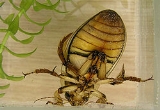
Dytiscus marginalis
Encyclopedia
The great diving beetle, Dytiscus marginalis, is a large aquatic diving beetle native to Europe
and northern Asia
, and is particularly common in England
.
The great diving beetle, true to its name, is a rather sizable insect. The larvae can grow up to 60 mm in length, while the adults are generally between 27-35 mm.
These beetles live in fresh water
, either still or slow-running, and seem to prefer water with vegetation. They are dark-coloured (brown to black) on their back and wing cases (elytra) and yellow on their abdomen and legs
. The male's wing cases are shiny, while those of the female are finely grooved. A voracious predator, this beetle hunts a wide variety of prey, including other insect
s, tadpole
s, and small fish
.
They are able fliers, usually at night, when they use the reflection of moonlight to locate new water sources, this location method can sometimes cause them to land on wet roads or other hard wet surfaces.
Before they dive, they collect air bubbles in their wing cases which goes through the spiracles. The jaws of a great diving beetle are strong compared to their body size.
Illustrated and described in detail as Plate 99, British Entomology
by John Curtis (entomologist)
(published London, 1814-39) labelled "Dyticus dimidiatus"
Europe
Europe is, by convention, one of the world's seven continents. Comprising the westernmost peninsula of Eurasia, Europe is generally 'divided' from Asia to its east by the watershed divides of the Ural and Caucasus Mountains, the Ural River, the Caspian and Black Seas, and the waterways connecting...
and northern Asia
Asia
Asia is the world's largest and most populous continent, located primarily in the eastern and northern hemispheres. It covers 8.7% of the Earth's total surface area and with approximately 3.879 billion people, it hosts 60% of the world's current human population...
, and is particularly common in England
England
England is a country that is part of the United Kingdom. It shares land borders with Scotland to the north and Wales to the west; the Irish Sea is to the north west, the Celtic Sea to the south west, with the North Sea to the east and the English Channel to the south separating it from continental...
.
The great diving beetle, true to its name, is a rather sizable insect. The larvae can grow up to 60 mm in length, while the adults are generally between 27-35 mm.
These beetles live in fresh water
Fresh Water
Fresh Water is the debut album by Australian rock and blues singer Alison McCallum, released in 1972. Rare for an Australian artist at the time, it came in a gatefold sleeve...
, either still or slow-running, and seem to prefer water with vegetation. They are dark-coloured (brown to black) on their back and wing cases (elytra) and yellow on their abdomen and legs
Arthropod leg
The arthropod leg is a form of jointed appendage of arthropods, usually used for walking. Many of the terms used for arthropod leg segments are of Latin origin, and may be confused with terms for bones: coxa , trochanter , femur, tibia, tarsus, ischium, metatarsus, carpus, dactylus ,...
. The male's wing cases are shiny, while those of the female are finely grooved. A voracious predator, this beetle hunts a wide variety of prey, including other insect
Insect
Insects are a class of living creatures within the arthropods that have a chitinous exoskeleton, a three-part body , three pairs of jointed legs, compound eyes, and two antennae...
s, tadpole
Tadpole
A tadpole or polliwog is the wholly aquatic larval stage in the life cycle of an amphibian, particularly that of a frog or toad.- Appellation :...
s, and small fish
Fish
Fish are a paraphyletic group of organisms that consist of all gill-bearing aquatic vertebrate animals that lack limbs with digits. Included in this definition are the living hagfish, lampreys, and cartilaginous and bony fish, as well as various extinct related groups...
.
They are able fliers, usually at night, when they use the reflection of moonlight to locate new water sources, this location method can sometimes cause them to land on wet roads or other hard wet surfaces.
Before they dive, they collect air bubbles in their wing cases which goes through the spiracles. The jaws of a great diving beetle are strong compared to their body size.
Illustrated and described in detail as Plate 99, British Entomology
British Entomology
British Entomology is a classic work of entomology by John Curtis, F.L.S.Described as British Entomology, being illustrations and descriptions of the genera of insects found in Great Britain and Ireland; containing coloured figures from nature of the most rare and beautiful species, and in many...
by John Curtis (entomologist)
John Curtis (entomologist)
John Curtis was an English entomologist and illustrator.-Biography:Curtis was born in Norwich and learned his engraving skills in the workshop of his father, Charles Morgan Curtis...
(published London, 1814-39) labelled "Dyticus dimidiatus"

